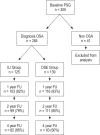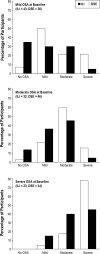Long-term effect of weight loss on obstructive sleep apnea severity in obese patients with type 2 diabetes
- PMID: 23633746
- PMCID: PMC3624818
- DOI: 10.5665/sleep.2618
Long-term effect of weight loss on obstructive sleep apnea severity in obese patients with type 2 diabetes
Abstract
Study objectives: To examine whether the initial benefit of weight loss on obstructive sleep apnea (OSA) severity at 1 year is maintained at 4 years.
Design: Randomized controlled trial with follow-up at 1, 2, and 4 years.
Setting: 4 Look AHEAD clinical centers.
Participants: Two hundred sixty-four obese adults with type 2 diabetes and OSA.
Interventions: Intensive lifestyle intervention with a behavioral weight loss program or diabetes support and education.
Measurements: Change in apnea-hypopnea index on polysomnogram.
Results: The intensive lifestyle intervention group's mean weight loss was 10.7 ± 0.7 (standard error), 7.4 ± 0.7, and 5.2 ± 0.7 kg at 1, 2, and 4 years respectively, compared to a less than 1-kg weight loss for the control group at each time (P < 0.001). Apnea-hypopnea index difference between groups was 9.7 ± 2.0, 8.0 ± 2.0, and 7.7 ± 2.3 events/h at 1, 2 and 4 years respectively (P < 0.001). Change in apnea-hypopnea index over time was related to the amount of weight loss (P < 0.0001) and intervention, independent of weight loss (P = 0.001). Remission of OSA at 4 years was 5 times more common with intensive lifestyle intervention (20.7%) than diabetes support and education (3.6%).
Conclusions: Among obese adults with type 2 diabetes and OSA, intensive lifestyle intervention produced greater reductions in weight and apnea-hypopnea index over a 4 year period than did diabetes support and education. Beneficial effects of intensive lifestyle intervention on apneahypopnea index at 1 year persisted at 4 years, despite an almost 50% weight regain. Effect of intensive lifestyle intervention on apnea-hypopnea index was largely, but not entirely, due to weight loss.
Keywords: Apnea-hypopnea index; polysomnogram.
Figures




Comment in
-
Weight Loss and obstructive sleep apnea: what lies AHEAD?Sleep. 2013 May 1;36(5):627-9. doi: 10.5665/sleep.2608. Sleep. 2013. PMID: 23633741 Free PMC article. No abstract available.
Similar articles
-
Effects of Weight Loss on Obstructive Sleep Apnea Severity. Ten-Year Results of the Sleep AHEAD Study.Am J Respir Crit Care Med. 2021 Jan 15;203(2):221-229. doi: 10.1164/rccm.201912-2511OC. Am J Respir Crit Care Med. 2021. PMID: 32721163 Free PMC article. Clinical Trial.
-
Sleep architecture following a weight loss intervention in overweight and obese patients with obstructive sleep apnea and type 2 diabetes: relationship to apnea-hypopnea index.J Clin Sleep Med. 2014 Nov 15;10(11):1205-11. doi: 10.5664/jcsm.4202. J Clin Sleep Med. 2014. PMID: 25325608 Free PMC article. Clinical Trial.
-
Effects of a lifestyle intervention on REM sleep-related OSA severity in obese individuals with type 2 diabetes.J Sleep Res. 2017 Dec;26(6):747-755. doi: 10.1111/jsr.12559. Epub 2017 May 31. J Sleep Res. 2017. PMID: 28560832 Free PMC article. Clinical Trial.
-
Weight Management in Obstructive Sleep Apnea: Medical and Surgical Options.Sleep Med Clin. 2019 Mar;14(1):143-153. doi: 10.1016/j.jsmc.2018.10.002. Sleep Med Clin. 2019. PMID: 30709529 Review.
-
Surgical and Nonsurgical Weight Loss for Patients with Obstructive Sleep Apnea.Otolaryngol Clin North Am. 2020 Jun;53(3):409-420. doi: 10.1016/j.otc.2020.02.003. Epub 2020 Apr 23. Otolaryngol Clin North Am. 2020. PMID: 32334866 Review.
Cited by
-
Body Mass Index Reduction and Selected Cardiometabolic Risk Factors in Obstructive Sleep Apnea: Meta-Analysis.J Clin Med. 2021 Apr 2;10(7):1485. doi: 10.3390/jcm10071485. J Clin Med. 2021. PMID: 33918454 Free PMC article. Review.
-
Heterogeneity of Treatment Effects From an Intensive Lifestyle Weight Loss Intervention on Cardiovascular Events in Patients With Type 2 Diabetes: Data From the Look AHEAD Trial.Diabetes Care. 2019 Oct;42(10):1988-1994. doi: 10.2337/dc19-0776. Epub 2019 Aug 15. Diabetes Care. 2019. PMID: 31416897 Free PMC article. Clinical Trial.
-
Non-pharmacological Treatment Options in the Management of Diabetes Mellitus.Eur Endocrinol. 2018 Sep;14(2):31-39. doi: 10.17925/EE.2018.14.2.31. Epub 2018 Sep 10. Eur Endocrinol. 2018. PMID: 30349592 Free PMC article. Review.
-
Obstructive sleep apnea: transition from pathophysiology to an integrative disease model.J Sleep Res. 2022 Aug;31(4):e13616. doi: 10.1111/jsr.13616. Epub 2022 May 24. J Sleep Res. 2022. PMID: 35609941 Free PMC article. Review.
-
The role of the androgen receptor in the pathogenesis of obesity and its utility as a target for obesity treatments.Obes Rev. 2022 Jun;23(6):e13429. doi: 10.1111/obr.13429. Epub 2022 Jan 27. Obes Rev. 2022. PMID: 35083843 Free PMC article. Review.
References
Publication types
MeSH terms
Grants and funding
LinkOut - more resources
Full Text Sources
Other Literature Sources
Medical

